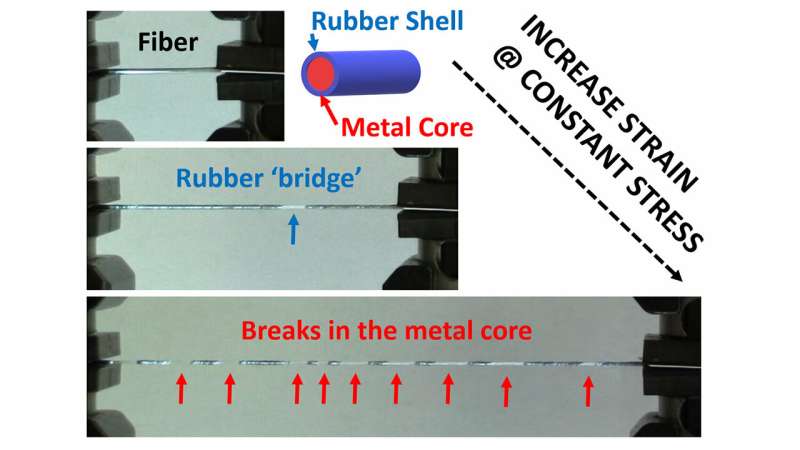Researchers engineer a tougher fiber

North Carolina State University researchers have developed a fiber that combines the elasticity of rubber with the strength of a metal, resulting in a tougher material that could be incorporated into soft robotics, packaging materials or next-generation textiles.
"A good way of explaining the material is to think of rubber bands and metal wires," says Michael Dickey, corresponding author of a paper on the work and Alcoa Professor of Chemical and Biomolecular Engineering at NC State.
"A rubber band can stretch very far, but it doesn't take much force to stretch it," Dickey says. "A metal wire requires a lot of force to stretch it, but it can't take much strain—it breaks before you can stretch it very far. Our fibers have the best of both worlds."
The researchers created fibers consisting of a gallium metal core surrounded by an elastic polymer sheath. When placed under stress, the fiber has the strength of the metal core. But when the metal breaks, the fiber doesn't fail—the polymer sheath absorbs the strain between the breaks in the metal and transfers the stress back to the metal core. This response is similar to the way human tissue holds together broken bones.
"Every time the metal core breaks it dissipates energy, allowing the fiber to continue to absorb energy as it elongates," Dickey says. "Instead of snapping in two when stretched, it can stretch up to seven times its original length before failure, while causing many additional breaks in the wire along the way.
"To think of it another way, the fiber won't snap and drop a heavy weight. Instead, by releasing energy repeatedly through internal breaks, the fiber lowers the weight slowly and steadily."
In materials, toughness is a material's ability to absorb energy and deform without breaking. You can think of it as the amount of force a material can absorb as it is deformed over a distance. The new fiber is far tougher than either the metal wire or the polymer sheath on its own.
"There's a lot of interest in engineering materials to mimic the toughness of skin—and we have developed a fiber that has surpassed the toughness of skin yet is still elastic like skin," Dickey says.
In addition, the gallium core is conductive—though it loses its conductivity when the internal core breaks. The fibers can also be reused by melting the metal cores back together.
"We used gallium for this proof of concept work, but the fibers could be tuned to alter their mechanical properties, or to retain functionality at higher temperatures, by using different materials in the core and shell," Dickey says.
"This is only a proof of concept, but it holds a lot of potential. We are interested to see how these fibers could be used in soft robotics or when woven into textiles for various applications."
The paper, "Toughening stretchable fibers via serial fracturing of a metallic core," is published in the journal Science Advances.
More information: C.B. Cooper el al., "Toughening stretchable fibers via serial fracturing of a metallic core," Science Advances (2019). DOI: 10.1126/sciadv.aat4600 , advances.sciencemag.org/content/5/2/eaat4600
Journal information: Science Advances
Provided by North Carolina State University





















